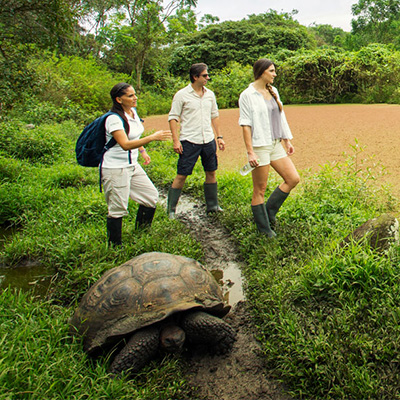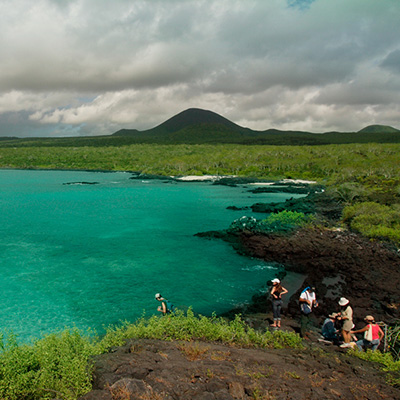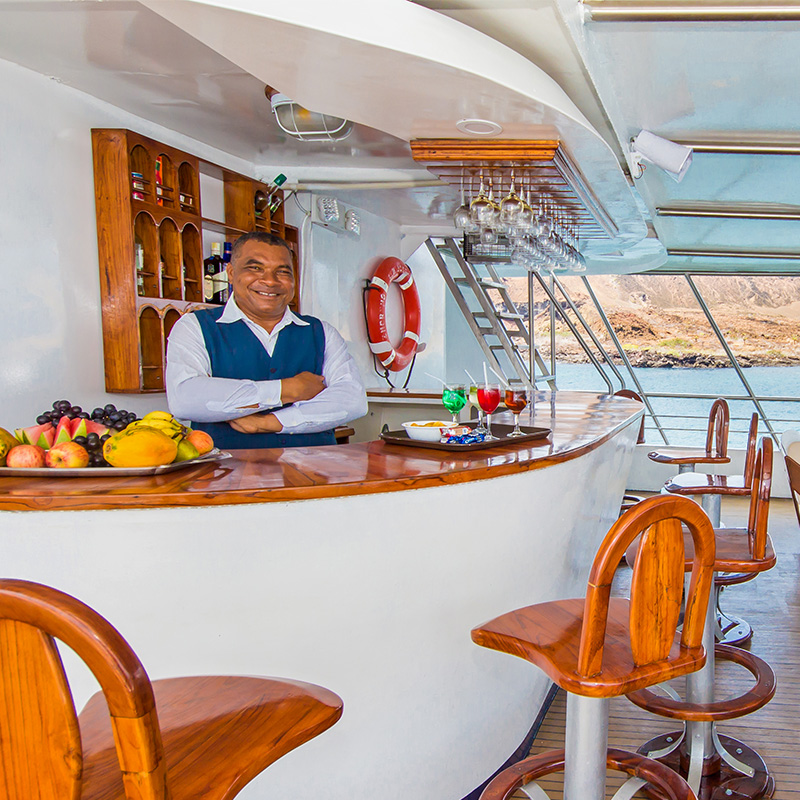GTEG-123 – M/Y GALAPAGOS SAN JOSE CRUISE ITINERARIES
EIGHT DAYS / SEVEN NIGHTS (ITINERARY “B”) – TUESDAY TO TUESDAY
Detailed Itinerary
DAY 1: TUESDAY ARRIVAL IN GALAPAGOS ISLAND
Baltra and Mosquera Islet
This morning you arrival at Baltra Airport. In front of the arrival area you will meet your naturalist guide and fellow passengers who will assist you in the shuttle transfer to the Baltra Dock where inflatable dinghies (‘zodiacs’) take you the last stretch to the yacht.
Mosquera lies in the middle of the Itabaca Channel, between Baltra and North Seymour. Mosquera is a pleasant start of your Galapagos visit, without the necessity to navigate a long stretch to get first contact with the unique insular nature. Moreover it’s one of the few spots inside the National Park where you can stroll around freely.
Galapagos sea lions are real beach lovers and Mosquera offers them the ideal site with its beautiful white coral sand.
DAY 2: WEDNESDAY – GALAPAGOS ISLANDS
Genovesa Island
Darwin Bay
Genovesa’s horseshoe-shaped wall is proof that we have anchored inside the partly collapsed and submerged caldera of a submarine volcano! The visitor’s site, Darwin Bay, is located at the very rear. This compact site shows the extreme variety of coastal ecosystems of the Galapagos in miniature. The trail starts from the coral sand beach and subsequently passes a zone with saltbushes and mangroves, then crosses tidal creeks and barren lava formations, dry shrub lands, and finally turns on the ridge of some cliffs. In this extremely varied and peaceful ambience, every single species has occupied its own ecological niche without disturbing others. Whimbrels and wandering tattlers forage actively along the surf, next to resting Galapagos sea lions. Herons wait motionless at the tidal pools. Impressive frigate birds (both great and magnificent species) and red-footed boobies nest in the mangroves, where you can also notice some vocalists such as yellow warblers, Darwin’s finches and Galapagos mockingbirds. Tropicbirds, Nazca boobies, storm petrels, endemic lava- and swallow-tailed gulls soar along the cliffs. When you have already seen marine iguanas elsewhere, the small Genovesa species might not look too impressive, but consider that these are virtually the only reptiles that succeeded to reach and survive on this remote, upstream island (and have become endemic to this island).
Prince Phillip’s Steps
Before landing you will take a dinghy-ride along the eastern arm of the caldera. On approach, the 80 feet walls become overwhelming, and will give you a better impression of the dimensions of this crater. Sometimes a Galapagos fur seal will be resting on one of the shaded ledges. Although there are also seabirds, the real spectacle will take place on top and on the outside of the rim, which provide better perching and nesting places. You will therefore have to hike and overcome the steep stairs from the landing dock to a bush of palo santo shrubs on top. Tropical dry forest vegetation appears dead during most months of the year, but just drops its leaves to prevent drying out by evaporation. It’s a threatened ecosystem. Red-footed boobies with different plumages gratefully use these scarce nesting-places. At the seaside of the rim, the bushes open up and you can enjoy wide views, a strong sea breeze and the amazing flying skills of countless seabirds. Following the exposed rim you will first pass a colony of Nazca boobies and finally reach the extensive storm-petrel nesting places.
Meals: Breakfast, lunch, dinner
DAY 3: THURSDAY – GALAPAGOS ISLANDS
South Plaza
The south of both Plaza islets is the best place to encounter endemic Galapagos land iguanas. Watch your step and don’t stumble over one of them whilst distracted by the equally bizarre giant prickly pear actus-trees! These iguanas are not only ugly as Darwin pronounced, but also very patient and photogenic models with strikingly saffron colors. Overpopulation and severe food competition have affected their smaller size. It is incredible to see how cactus spines don’t harm them while chewing pads, flowers and fruits. Also look out for some unique hybrids between a male marine iguana and a female land iguana. Arriving at the upper rim, you get to know the other, wild and windy face of South Plaza that provides a completely different habitat. Being talented rock climbers, sun basking marine iguanas have escaped the cool shadows of the wall. Clouds of petrels, storm petrels, shearwaters make spectacular flights and sometimes appear to walk on the waves. Take your binoculars and don’t miss the red-billed tropicbird with its graceful long tail and spectacular mating fights. These cliffs are also a nesting place for the endemic swallow-tailed gull, the most beautiful gull in the world. Its neatly lined eyes are perfectly adapted for its exceptional nightly fishing habits.
Barrington Bay, Santa Fe Island
Practically every animal on Santa Fe is unique; endemic to the Galapagos and extremely vulnerable! This extraordinary island is a remnant of probably the most ancient. Your experience starts before anchoring, when the contours of its bizarre giant prickly pear cactus (opuntia) forests become distinguishable. These largest cacti of the islands have extremely thick trunks and can grow over 33 feet tall! You will land right in the middle of a Galapagos sea lion colony on the beach. From their outlooks at the beach ridge surprisingly fearless Galapagos hawks are ready to snatch away a lava lizard; not worrying that even these are unique… Almost every visitor of Santa Fe becomes eager to get a glimpse of the rare Barrington land iguana. But this pale endemic version is not as easy to spot as its modeling counterparts on South Plaza. Whether you spot it or not, you will keep going from one surprise to the next. While snorkeling in the azure-colored Barrington Bay between tropical reef fish, maybe a curious Galapagos sea lion will be willing to play with you!
Meals: Breakfast, lunch, dinner
DAY 4: FRIDAY GALAPAGOS ISLANDS
Kicker Rock (San Cristobal)
Kicker Rock has become one of the photogenic landmarks of the Galapagos. Clearly visible from afar, nature has mold a massive offshore block of rock with a pointy tower next to it. Reaching about 500 feet above sea level this compact rock is thought to be the remnant of a former tuff cone, which has eroded completely away.
While sailing around and spotting blue-footed boobies and great frigate birds you can observe this intriguing sculpture from changing angles. From the side it takes the form of a giant shoe, upside down with the tower as the high heel (hence its English name Kicker Rock). In longitudinal direction it rather resembles a sleeping lion (hence its Spanish name Leon Dormido).
These steep walls rise out of the deep sea. Kicker Rock is one of the favorite locations amongst scuba divers and snorkelers in the south-eastern archipelago. Amid colorful tropical fish you might have thrilling encounters with octopuses, different species of shark (including scalloped hammerhead sharks!), Pacific green turtles, spotted eagle rays and even – when you are really lucky – with barracudas, manta rays and giant oceanic manta rays!
Interpretation Centre (San Cristobal)
The Interpretation Centre just outside Puerto Baquerizo Moreno is a perfect introduction as well as an interesting complement to the field-explanations and briefings of your naturalist guide. This Centre tells the background story of the islands and it helps you to get an overview and learn what makes the Galapagos so unique. The well-maintained botanical garden with native species from the arid zone (including the giant prickly pear and candelabra cacti) is worth your visit as well. The attractive exhibition is quite complete and explains a series of natural circumstances that created the Galapagos’ unique environment: such as the volcanic genesis of the islands, their remoteness from the continent, its ocean currents, its special climate, the arrival of different species, and their establishment, among others.
Meals: Breakfast, lunch, dinner
DAY 5: SATURDAY – GALAPAGOS ISLANDS
Española Island
Gardner Bay
Make your first ‘dive’ into the alluring turquoise-colored Gardner Bay and admire colorful reef fish, snorkel side by side with a Pacific green turtle, or find yourself in the middle of playful Galapagos sea lions. The striking white coral sandy beach is an important breeding site for Pacific green turtles, but without doubt its main attraction is the Galapagos sea lion colony. During the breeding- and mating season the colony becomes even more populous. The strongest bachelors and elder males return from their secluded bases and start again to conquer and defend their part of the long beach.
Punta Suarez (Española Island)
Huge ocean waves crash on the southern basaltic cliffs of Suarez Point, and form a spectacular blowhole, where a fountain of sea water sprays feet high into the air. Waved albatrosses soar for most of their lives far out at sea and just come to Española (March-December) to breed and nurture their huge chicks. This spectacular seabird is the only tropic albatross (critically endangered species) and only breeds on Española, where you can witness its synchronous courtship dances, which include bowing, whistling and even a stylized form of ‘sword fighting’ with their bills.
Suarez Point is also a massive breeding site for Nazca and blue-footed boobies, swallow-tailed gulls and red-billed tropicbirds. Particularly during the food-abundant garúa-season (second half of the year) you can admire amusing courtship dances, mating, breeding, emerging from the eggs, nurturing or first flight-attempts. Española marine iguanas become bright red with a turquoise-colored crest and legs at the start of the breeding season. Hood lava lizards are the largest of the 7 endemic species in the islands, as well as endemic mockingbirds.
Meals: Breakfast, lunch, dinner
DAY 6: SUNDAY – GALAPAGOS ISLANDS
Floreana Island
Cormorant Point
The peninsula of Cormorant Point forms the extreme north cape of Floreana, which is pockmarked by a numbers of smaller volcanic cones and covered by tropical dry forest (predominantly palo santo). Please don’t expect to spot the flightless cormorant at Cormorant Point. Instead, its salty lagoon is one of the best places on the Galapagos to observe a breeding colony of American flamingos. When breeding is done and the lagoon dries up, these exotic birds tend to be on the move to look for shrimps and algae from other saline lakes.
At the landing beach, you will be welcomed by a small Galapagos sea lion-colony. The green sand contains a high percentage of glassy olivine crystals that have been blown out by the surrounding tuff cones. The ‘flour sand’ beach on the south side of the peninsula feels very smooth on your feet; this is pulverized by parrotfishes. Schools of stingrays in the surf love using this powdery sand to hide themselves, and Pacific green turtles come ashore to bury their eggs in it at night (first months of the year).
Champion Islet (Floreana)
Bottlenose dolphins frequently escort the passage to Champion Islet and you can see them nearby jumping the wakes! This is just the prelude of an unforgettable snorkeling excursion. Galapagos sea lions turn into playful acrobats underwater – without a doubt the number one attraction. There are also lots of reef fish, and perhaps a Pacific green turtle. An inflatable dinghy ride along the shoreline of this islet offers sightings of lots of sea birds that are endemic to the archipelago, including Galapagos penguins, blue-footed boobies, magnificent frigate birds and red-billed tropicbirds, swallow-tailed gulls and lava herons. Most desired on every serious birder’s wish list is to get a glimpse of the Charles mockingbird on top of prickly pear cacti. To the unschooled eye this unique variant may look hardly any different to their relatives on other islands, but it is almost extinct (less than 250 birds). This mockingbird is a scientific and historic key species because it put Darwin on track of his theory of ‘adaptive radiation’.
Post Office Bay & Baroness Lookout (Floreana)
Bring your unstamped postcards and post them in the peculiar barrel on this historic site. The present barrel commemorates the improvised mail service between British 16th century whalers and poachers. Returning vessels also picked up letters for home delivery. Finally, this post box became the ending of the flourishing British whaling industry in this region (Moby Dick).
The arm of a submerged tuff cone protects the turquoise bay at Baroness Lookout. Besides Galapagos sea lions, Pacific green turtles and golden cow nose rays you might spot Galapagos penguins! This is the only place in the south-eastern archipelago where some penguins reside. Climb the miniature basaltic cone of Baroness Lookout and dream away at the paradisiacal coast-scape. This viewpoint was the favorite spot of one of Floreana’s first colonists, the eccentric Baroness and self-proclaimed ‘Empress of Galapagos’ Eloisa von Wagner Bosquet.
Meals: Breakfast, lunch, dinner
DAY 7: MONDAY – GALAPAGOS ISLANDS
Bartolome Island
Sullivan Bay (Santiago)
Setting foot at the lava stream covering Sullivan Bay is like landing on the moon. The desolate, stretched-out fields seem mostly lifeless, but there is enough to see on this highly popular site amongst photographers. Graphical bas-reliefs of rope-lava in the crust are unique to the Galapagos and Hawaii. There is even some life! Pacific green turtles seasonally bury eggs in the tiny white sand beach, where you may also encounter crabs, a strayed blue heron or oystercatcher. You might encounter a lava lizard, locusts or a small snake species (Galapagos racer) hunting for them. The barely eroded lava flow seems to have been solidified for short, and suggests that you are just able to set foot on it. The baking sun completes the sensation of heat. The winding and rippled pahoehoe rope-lava has preserved intriguing traces that tell flaming stories about vaporized leatherleaf trees and miniature cones of volcanic glass. Distinctive tuff cones pockmark the new-formed lunatic landscape. Their rusty, oxidized colors and vegetation reveal that these are from an older generation. Originally these were volcano islets on their own that have become part of Santiago during the latest eruption (1897), when the hot flood of ooze filled up large parts of the bay, which is the black crust you walk on. For the time being only the opposite islet of Bartolomé escaped from incorporation. Ecologically these cones can still be considered as islands, though no longer surrounded by sea, but by wide infertile lava fields.
Bartolome Island
The wild romantic volcano islet of Bartolomé is among the youngest of the islands, and on a geological scale just recently born out of fire. Although tiny (only 300 acres) and at first sight lifeless, Bartolomé offers some of the wildest landscapes and best panoramas in the entire archipelago. To enjoy the postcard view of the idyllic ‘Pinnacle Bay’ you have to climb the stairs to the viewpoint on top of the island (375ft). Suddenly enter a dramatic world of threatening (though extinguished) nearby spatter cones, craters, and lightweight lava droplets that have been spewed out by fiery fountains. The Summit Trail is also ideal for witnessing how scanty pioneer vegetation such as lava cactus is struggling to take root in the bare virgin lava fields. From the summit you suddenly face a second, paradisiacal world; Galapagos’ landmark ‘Pinnacle Rock’ towers prominently over an isthmus with crescent sand beaches on each side, and dunes with evergreen mangrove bushes in-between. Underwater, a third, completely distinctive world opens up to you, resembling a tropical aquarium. Its shallow, clear and warm waters are ideal for snorkeling between coral-grinding parrot fishes, shoals of surgeon fishes, harmless whitetip reef sharks and Pacific green turtles.
Meals: Breakfast, lunch, dinner
DAY 8: TUESDAY – DEPART GALAPAGOS ISLANDS
Even at the very end of your cruise the Galapagos Islands keep surprising. On this last morning you will explore the ever green mangle forest of Black Turtle Cove and feel as if you are in the Amazon rainforest instead of at the north coast of Santa Cruz. These lagoons and adventurous creeks teem with marine and birdlife, and (seasonally) with mating turtles and sharks. By inflatable dinghy we will explore the calm emerald lagoon and enter the surrounding shallow creeks of these salt-water marshes. You have to keep your eyes peeled when looking around and staring into the crystal clear waters to observe all the life that is flying and swimming around. You can spot silently hunting lava herons on the banks and brown pelicans nesting on top of the mangroves. Various species of ray and shark come to this nutritious cradle to give birth; scalloped hammerhead sharks come back to the place where they’re born and their babies tend to be close to the surface. Pacific green turtles visit this cove in their reproduction season (November-January).
Transfer to Baltra airport assisted by the naturalist guide who will accompany you to the check-in counters in the departure hall. We expect you to return home with stunning pictures and unforgettable memories for life!








